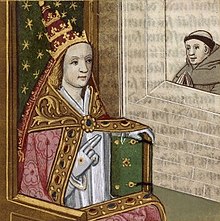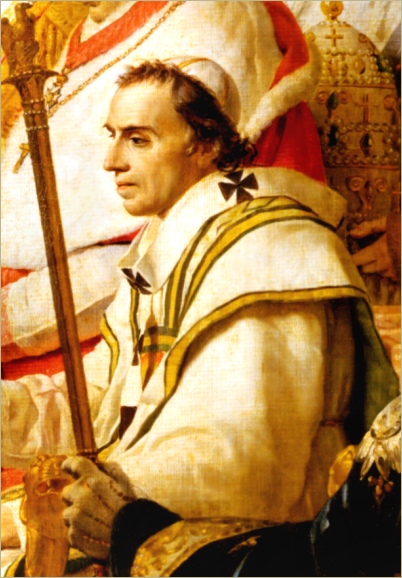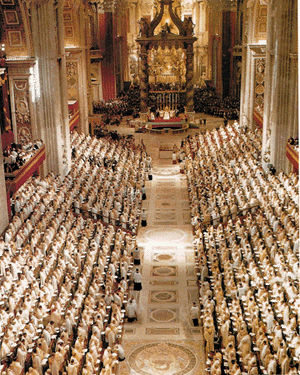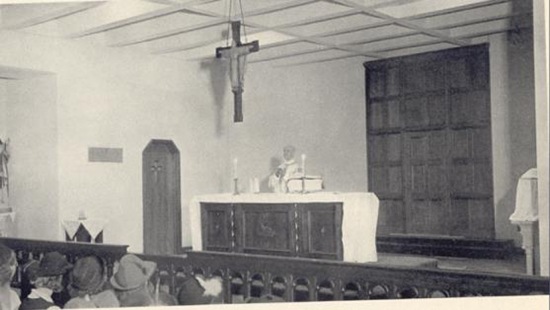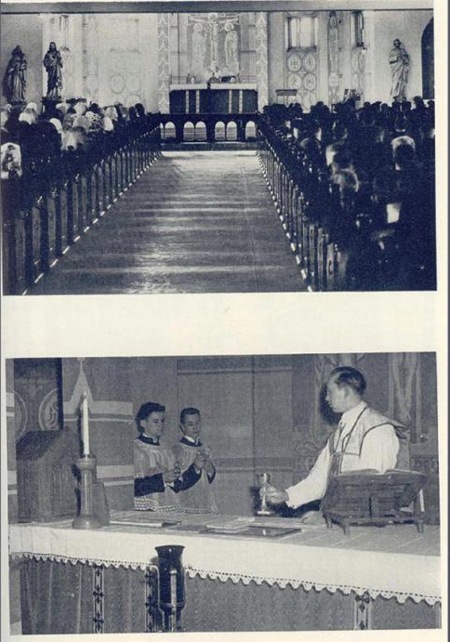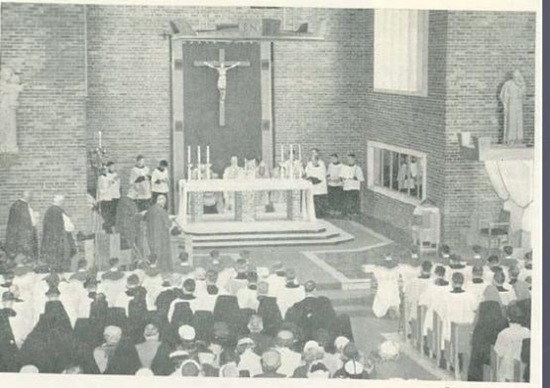Today's post, the penultimate "reason" before our conclusions, focuses on centralization in the Roman liturgy which followed the Council of Trent and eventually facilitated the reforms of the Roman rite during the papacies of St. Pius X, Pius XII, John XXIII, and Paul VI, as well as the legislation of John Paul II and Benedict XVI. Aside from providing a means for the reforms to present themselves to the Church, centralization changed the mindset of the Church of Rome and of her clergy toward the worship of God.
Following the Council of Trent, St. Pius V issued two papal bulls Quod a nobis and Quo primum, promulgating a Divine Office and a Missal which, although not always obligatory, could be used by any priest in the Latin rite of the Church without exception. To the modern reader this hardly seems shocking. The revised English translation of the new rite of Mass came at Rome's behest, the diocesan bishops, at least in the United States, liked the old translation, even the erroneous "for all" in the consecration of the chalice. We can easily lose sight of how drastic a change this was.
 |
Paschal Mass in the Lyonese rite, some very different texts
from Rome's Resurrexi. |
From the earliest days of Christianity in the West, the liturgy developed at a local level and took on the characteristics of both the people who celebrated it and of the rites of major churches within the same area. In Europe, the city of the Rome was the most influential church "in the same area." I suspect this is what so many modern day commentators mean when they discuss "organic" development. Charlemagne accelerated a process already underway, whereby bishops would seek to emulate the liturgy as it was practiced in the city of Rome. This meant following the Latin language, the basic structure of the Mass, the schedule of the hours of the Divine Office, the structure of the Office, loosely the arrangement of the psalms, and many of the prayers. Yet no one diocese had the same exact rite as another. Indeed, within the city of Rome the Divine Office varied by church. In some cathedrals each priest might say a slightly different private Mass in his chapel. Yet, any observer of a Mass in Cluny, St. John Lateran, or the Cathedral of Canterbury would recognize that the same ritual, spirituality, faith, and objectives were being followed. The late Laszlo Dobszay, whose work I find myself constantly recommending, notes that the neo-Gallican graduals are almost all the same text as in the "Tridentine" Roman rite, although this did not come to pass by legislation. Rites gradually converged as ideas and rites spread, but the Roman Canon and the Roman structure remained the barometers of liturgical order.

These rites could vary in their texts and their ceremonies, imbuing the liturgy with a very personal character. There existed in these local churches numerous abuses condemned by the 22nd session of the Council of Trent, and rightly so. Votive Requiem Masses have no place on Sundays or on great feasts. Priests should not charge stipends for
missis siccis. Pius V, Pope immediately after Trent, determined to correct any potential abuses or defects in priestly life or in religious practice by imposing a streamlined version of the Roman Curia's liturgy on the Latin Church at large. He did so at the behest of the Council of Trent, but eventually promulgated the rites under Papal authority. One correspondent of mine observed that
Quod a nobis, the 1568 bull concerning the Divine Office, is brimming with "aggression and conquest." He might have been right.
The immediate effects of Pius V's actions were two-fold:
The bottom-up problem: local rites, unless they were more than two hundred years old, died immediately and could no longer contribute to the development of the liturgy in the Church. Even some older rites did not last. Rome attempted for centuries after Trent to suppress the local usages of France, particularly the Parisian rite. Anyone interested can find at least one edition of the Missale Parisiense on Google Books. The rites of Braga, Lyons, and Milan were similarly targeted, but managed to survive until the Second Vatican Council.
The top-down problem: the Roman liturgy becomes a product under corporate management and subject to quality tests.
First, the bottom-up issue. The suppression or de facto extinction of local usages and variations of the Roman rite was not immediately troublesome, but blurred the character of local churches—and each church is a unique Christian community—and removed their own expression of belief. Aside from the personal investment people had in worshiping as their fathers had, people had grown accustomed to singing hymns to particular chants and in local tones, to distinct ceremonies and rituals—especially during Holy Week, and the liturgy of the cathedrals revolved around these communal celebrations, led by the bishop and his convened chapter. All of this either vanished or became a tolerated exception under the bulls of 1568 and 1570.
Local uses of Rome disappeared almost immediately, although a few oddities, like the Lateran Cathedral's refusal to sing Dona nobis pacem for the third invocation in the Agnus Dei remained. Why does this matter? Roman churches each celebrated the liturgy somewhat differently. Hymns and chants are great examples as to how. Local churches would often repeat the same hymn from day to day, or from feast to feast, and utilize simple melodies so that the ignorant could sing along and memorize these chants through repetition. The uses of the Carmelites, Dominicans, and Carthusians better preserve this principle than the rite of 1570.
 |
| Ecce lignum crucis.... |
While considering this point, we ought to meditate on the 1570 Missale Romanum. The 1570 Missal and 1568 Office are trimmed down versions of the same books used in the Roman Curia a century earlier. The Henry Bradshaw Society reprinted the 1474 Missale Romanum a few years ago, should any of you wish to purchase a copy. St. Pius V specified some rubrics, explicitly added the Last Gospel (formerly said in procession rather than at the altar), deleted Gallican prefaces and sequences, slashed a few feasts (including of Ss. Joachim and Ann), and adjusted other points in the Office which elude me. The reformers of the post-Tridentine period purported that this Missal represented the liturgy of the time of St. Gregory VII. It may well have been the liturgy as it was practiced by the Papal Court in the eleventh century, in fact it was probably very close, but no closer than any of the other local usages to the essence of the Roman rite as a liturgy diffused throughout Europe.
Here comes a secondary negative effect. The Missal of the Roman Curia was made for small scale, simple, timely celebrations by bureaucrats who had other work to do. The Pope, until 1964, had his own rite of Mass very befitting the dignity of his office. The Curia, on the other hand, was a body of priests and cardinals, who operated in chapels rather than large churches, who did so in the presence of similarly educated people, aided by professional singers, and who wished to make these rites as succinct as possible. These rites were consequently very simple in ceremony and sometimes stark in text compared to the larger Roman liturgy spread throughout Europe.
For example: on Good Friday in the 1474-1955 Roman Missals, the deacon gives the priest a veiled crucifix, who exposes it in three moments, lays it on a pillow, and the choir sings the "reproaches" (Trisagion, Pange lingua etc) while those present adore it. In the Norman and neo-Gallican rites we see more clearly the function of the reproaches. The deacon brings the veiled crucifix through the church, or more likely, cathedral, whilst the choir sings the Trisagion: Agios o Theos! Agios ischyros! Agios athanatos, eleison imas! At the altar, the priest would then do the three familiar un-veilings and lay the crucifix down for adoration, during which the choir would sing Pange lingua and the subdeacon would "comment" by singing antiphons between the verses, antiphons which described Christ. Clearly, the Roman liturgy on Good Friday was a simplification made to suit a particular brand of practitioner.
Now we come to the second effect of this post-Tridentine centralization, the "brand" of the Roman liturgy.
 |
Palm Sunday according to the rite of Braga, but actually in Rhode Island.
source: newlitugicalmovement.org |
We have made the case that prior to Trent local dioceses based their liturgy around what Rome generally did and use Rome as an enduring standard. Now Rome did not nurture the liturgy, but actually imposed it from afar. Liturgy was something given to the clergy of the Roman rite, even if they were originally of another rite or use, by Papal decree. The Sacred Congregation for Rites, erected in 1588 by Sixtus V, managed the Roman liturgical books on the Pope's behalf, except when the Pope felt inclined to intervene, for instance when Urban VIII published his new and improved hymns.
The Roman Church became like McDonalds. The Pope was CEO, the cardinals formed a board of directors—each with his own congregation or department, bishops were the franchisees, and priests were restaurant managers who had to sell their product to the faithful customers. The product, the liturgy, must meet a given standard. Falling short of or exceeding the standard are not options.
This analogy is facetious, but contains some truth. Priests had to do whatever was in the books imposed by the Pope, no more, no less. If he celebrated, or said, Mass and recited the Office as instructed then he was, on one count, meeting expectations.
During the centuries after Trent no one paid too much attention to the liturgy outside of the cathedrals and monasteries. Theology, doctrine, devotion, and art dominated the Counter-Reformation and baroque epochs. Few seem to have bothered to adopt local customs, music, or ceremonial to the Roman liturgy, perhaps due to the phenomena examined in our posts on
low Mass culture and
Devotionalism. Local expression, even in a highly centralized liturgical setting, is not impossible. The Church of Antioch, after having the liturgy of Constantinople forced upon it, rejected ceremonies pertaining to the Byzantine court and continued to administer Holy Communion without the spoon. Not until the 19th century did clergy think about the liturgy, but by then popular perceptions of what constituted or created the liturgy had changed.
Most clergy accepted the 1911, 1955, and 1960 liturgical reforms without batting an eyelash. The right authorities promulgated these changes. Consideration of the merits of these changes was frivolous, perhaps even disobedient. Divino afflatu uses similar language to that of Pius V's decrees centuries earlier. When the more visible changes came through in 1964, 1965, 1967, 1968, and finally the new rite of Mass in 1969 and new Office in 1975, priests and bishops were expected to accept any changes because they came from Rome. Cardinal Ottaviani, who in his private "intervention" with Pope Paul VI wrote that the proposed new rite was a "striking departure from the Catholic theology of the Mass as it was formulated in Session XXII of the Council of Trent," eventually learned to accept the new rite in spite of his intuition. Ditto for Cardinals Bacci and Siri.
The legal authority Rome found itself possessing after Trent made a drastic overhaul somewhat inevitable. No longer were the Latin rites guarded by tradition, but they were given by a congregation in central Italy. This meant that whoever controlled that office or whoever had the Pope's ear could essentially have his way with the liturgy of western Christendom. It was only time before a large number of people from the Liturgical Movement found themselves in that position. Moreover, Rome no longer guards the liturgy. Rome is neither the aggressor nor the victim in the war over the liturgy. Rome is the battlefield.
This last point represents a problem for the "brick by brick" crowd, as they often rely on exercising the most conservative legal options when celebrating the Mass of Paul VI. What is the point of celebrating the Mass of Paul VI ad orientem and in Latin if one has to give Holy Communion in the hand? An Oratorian high Mass and an American suburban low Mass both follow the prescribed rules.
Rome must also find this phenomenon problematic. Benedict XVI's Summorum Pontificum stated that the Missal of John XXIII was never "abrogated." It may never have been explicitly suppressed, but after Inter oecumenici in 1964 priests could not have expected to be able to follow 1962. If 1962 is legal, are not 1967 and 1920?—two very different Missals. As Joseph Cardinal Ratzinger, the previous Pope wrote many commentaries on "organic" liturgy. He even sat on a commission with Cardinals Hoyos and Stickler which found the old rite perfectly legal for use. Question: which Missal was found legal for use? The 1962 rite? The "Tridentine" Mass? The "Mass of St. Pius V?" The "old rite?" Indeed, the choice of 1962 is now commonly acknowledged to be that of Archbishop Marcel Lefebvre, not of the Vatican. Still, why pick a year? I personally think Benedict XVI was aware the rites of Paul VI represented a departure from the established tradition of the Roman rite and wished to find some way of stating that the Church would never suppress her tradition, that its use was always legitimate. 1962 was the year most commonly used by "traditionalists," so that is the rite he declared was never "abrogated."
Perhaps the saddest consequence of this legalism and liturgical centralization is that decline of people's view of Rome as the spiritual center of the Church and of the Pope as the spiritual father. The Pope is just the man who makes the rules and the Vatican processes them. If in the early 13th century, I asked a priest in Canterbury Cathedral if Pope Innocent III had the power to depose King John, the priest would probably at least entertain the question: political power comes from God and the Pope is His vicar on earth. If I asked him if the same Pope could dictate every word and action of the Mass he just celebrated, the same priest would think me mad. Yet, I wager the same priest would not dare to change a punctuation mark in the Roman Canon, much less write a series of new anaphoras.
Thus ends my proposed list of causes of the reform of the Roman liturgy. In our next post, the last in this series, we will give a brief summation of what we have found, make a few conclusions, and, since I prefer to be part of the solution and not part of the problem, present some ideas for the future.
God bless.
